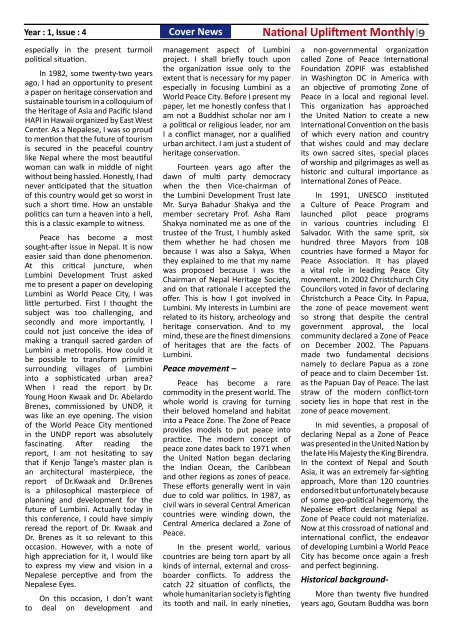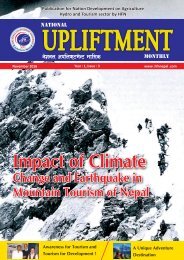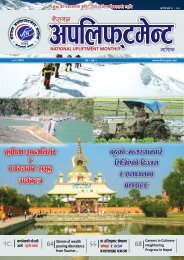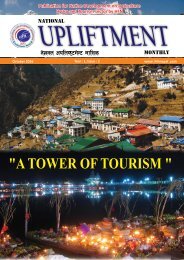Create successful ePaper yourself
Turn your PDF publications into a flip-book with our unique Google optimized e-Paper software.
Cover News<br />
Year : 1, Issue : 4 <strong>National</strong> <strong>Upliftment</strong> <strong>Monthly</strong> 9<br />
especially in the present turmoil<br />
political situation.<br />
In 1982, some twenty-two years<br />
ago, I had an opportunity to present<br />
a paper on heritage conservation and<br />
sustainable tourism in a colloquium of<br />
the Heritage of Asia and Pacific Island<br />
HAPI in Hawaii organized by East West<br />
Center. As a Nepalese, I was so proud<br />
to mention that the future of tourism<br />
is secured in the peaceful country<br />
like Nepal where the most beautiful<br />
woman can walk in middle of night<br />
without being hassled. Honestly, I had<br />
never anticipated that the situation<br />
of this country would get so worst in<br />
such a short time. How an unstable<br />
politics can turn a heaven into a hell,<br />
this is a classic example to witness.<br />
Peace has become a most<br />
sought-after issue in Nepal. It is now<br />
easier said than done phenomenon.<br />
At this critical juncture, when<br />
Lumbini Development Trust asked<br />
me to present a paper on developing<br />
Lumbini as World Peace City, I was<br />
little perturbed. First I thought the<br />
subject was too challenging, and<br />
secondly and more importantly, I<br />
could not just conceive the idea of<br />
making a tranquil sacred garden of<br />
Lumbini a metropolis. How could it<br />
be possible to transform primitive<br />
surrounding villages of Lumbini<br />
into a sophisticated urban area?<br />
When I read the report by Dr.<br />
Young Hoon Kwaak and Dr. Abelardo<br />
Brenes, commissioned by UNDP, it<br />
was like an eye opening. The vision<br />
of the World Peace City mentioned<br />
in the UNDP report was absolutely<br />
fascinating. After reading the<br />
report, I am not hesitating to say<br />
that if Kenjo Tange’s master plan is<br />
an architectural masterpiece, the<br />
report of Dr.Kwaak and Dr.Brenes<br />
is a philosophical masterpiece of<br />
planning and development for the<br />
future of Lumbini. Actually today in<br />
this conference, I could have simply<br />
reread the report of Dr. Kwaak and<br />
Dr. Brenes as it so relevant to this<br />
occasion. However, with a note of<br />
high appreciation for it, I would like<br />
to express my view and vision in a<br />
Nepalese perceptive and from the<br />
Nepalese Eyes.<br />
On this occasion, I don’t want<br />
to deal on development and<br />
management aspect of Lumbini<br />
project. I shall briefly touch upon<br />
the organization issue only to the<br />
extent that is necessary for my paper<br />
especially in focusing Lumbini as a<br />
World Peace City. Before I present my<br />
paper, let me honestly confess that I<br />
am not a Buddhist scholar nor am I<br />
a political or religious leader, nor am<br />
I a conflict manager, nor a qualified<br />
urban architect. I am just a student of<br />
heritage conservation.<br />
Fourteen years ago after the<br />
dawn of multi party democracy<br />
when the then Vice-chairman of<br />
the Lumbini Development Trust late<br />
Mr. Surya Bahadur Shakya and the<br />
member secretary Prof. Asha Ram<br />
Shakya nominated me as one of the<br />
trustee of the Trust, I humbly asked<br />
them whether he had chosen me<br />
because I was also a Sakya, When<br />
they explained to me that my name<br />
was proposed because I was the<br />
Chairman of Nepal Heritage Society,<br />
and on that rationale I accepted the<br />
offer. This is how I got involved in<br />
Lumbini. My interests in Lumbini are<br />
related to its history, archeology and<br />
heritage conservation. And to my<br />
mind, these are the finest dimensions<br />
of heritages that are the facts of<br />
Lumbini.<br />
Peace movement –<br />
Peace has become a rare<br />
commodity in the present world. The<br />
whole world is craving for turning<br />
their beloved homeland and habitat<br />
into a Peace Zone. The Zone of Peace<br />
provides models to put peace into<br />
practice. The modern concept of<br />
peace zone dates back to 1971 when<br />
the United Nation began declaring<br />
the Indian Ocean, the Caribbean<br />
and other regions as zones of peace.<br />
These efforts generally went in vain<br />
due to cold war politics. In 1987, as<br />
civil wars in several Central American<br />
countries were winding down, the<br />
Central America declared a Zone of<br />
Peace.<br />
In the present world, various<br />
countries are being torn apart by all<br />
kinds of internal, external and crossboarder<br />
conflicts. To address the<br />
catch 22 situation of conflicts, the<br />
whole humanitarian society is fighting<br />
its tooth and nail. In early nineties,<br />
a non-governmental organization<br />
called Zone of Peace International<br />
Foundation ZOPIF was established<br />
in Washington DC in America with<br />
an objective of promoting Zone of<br />
Peace in a local and regional level.<br />
This organization has approached<br />
the United Nation to create a new<br />
International Convention on the basis<br />
of which every nation and country<br />
that wishes could and may declare<br />
its own sacred sites, special places<br />
of worship and pilgrimages as well as<br />
historic and cultural importance as<br />
International Zones of Peace.<br />
In 1991, UNESCO instituted<br />
a Culture of Peace Program and<br />
launched pilot peace programs<br />
in various countries including El<br />
Salvador. With the same sprit, six<br />
hundred three Mayors from 108<br />
countries have formed a Mayor for<br />
Peace Association. It has played<br />
a vital role in leading Peace City<br />
movement. In 2002 Christchurch City<br />
Councilors voted in favor of declaring<br />
Christchurch a Peace City. In Papua,<br />
the zone of peace movement went<br />
so strong that despite the central<br />
government approval, the local<br />
community declared a Zone of Peace<br />
on December 2002. The Papuans<br />
made two fundamental decisions<br />
namely to declare Papua as a zone<br />
of peace and to claim December 1st.<br />
as the Papuan Day of Peace. The last<br />
straw of the modern conflict-torn<br />
society lies in hope that rest in the<br />
zone of peace movement.<br />
In mid seventies, a proposal of<br />
declaring Nepal as a Zone of Peace<br />
was presented in the United Nation by<br />
the late His Majesty the King Birendra.<br />
In the context of Nepal and South<br />
Asia, it was an extremely far-sighting<br />
approach, More than 120 countries<br />
endorsed it but unfortunately because<br />
of some geo-political hegemony, the<br />
Nepalese effort declaring Nepal as<br />
Zone of Peace could not materialize.<br />
Now at this crossroad of national and<br />
international conflict, the endeavor<br />
of developing Lumbini a World Peace<br />
City has become once again a fresh<br />
and perfect beginning.<br />
Historical background-<br />
More than twenty five hundred<br />
years ago, Goutam Buddha was born





